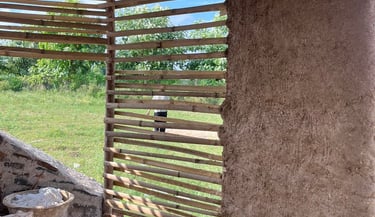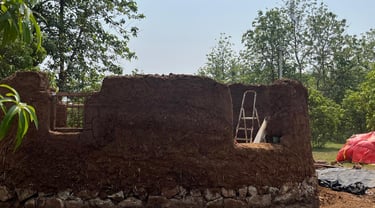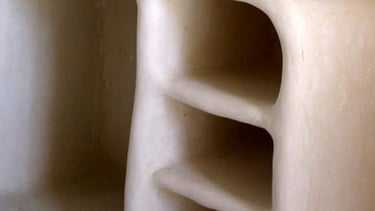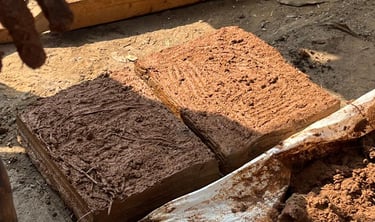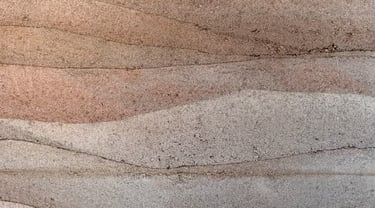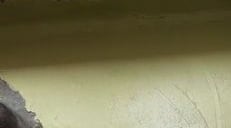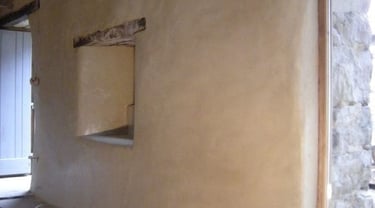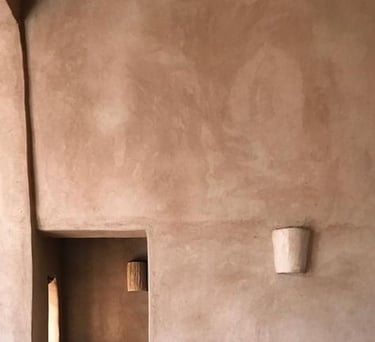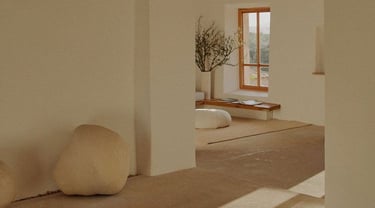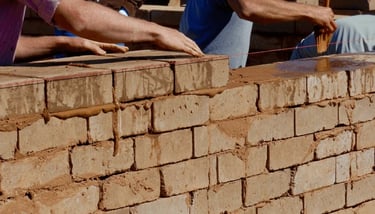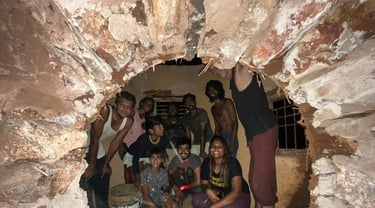These are some of the ecological building techniques that we use at KraftHom. There is a place for all these materials, and when applied with imagination, and in the right context, they create magic.
6,000-Year-Old Art of Flexible, Resilient Building
The flexibility and earthquake resistance of EARTH For over 6,000 years, this traditional walling system has demonstrated the remarkable strength, adaptability, and ease of construction that earth architecture offers. Wattle and Daub is a composite technique in which a framework of woven wooden sticks or split bamboo — the wattle — is coated with a clay-rich mixture of soil, chopped straw, hair, or animal dung — the daub. This combination creates walls that are not only resilient and flexible but also naturally suited to withstand seismic activity. Many historic buildings still showcase the durability of wattle and daub, and today, this timeless method is experiencing a well-deserved revival.
Few materials can match the mystery and refinement of lime, especially when shaped through the ancient Moroccan art of Tadelakt. This sacred craft, handed down from artisan to artisan through generations, demands both patience and extraordinary skill to achieve its distinctive, luxurious finish. Born from the limestone of Morocco’s High Atlas Mountains, Tadelakt has adorned the walls of Marrakesh palaces for centuries, their surfaces still gleaming with an almost untouched beauty. Today, this tradition continues to inspire modern craftsmen around the world, drawn to its elegance, endurance, and sensuality. In Arabic, Tadelakt means “to caress” — a fitting name for a finish that invites both the hand and the eye.
The Enduring Warmth of EARTH
Cob is one of the oldest and most beloved earth-building techniques, made from clay-rich soil, sand, straw, and water. Hand-shaped into thick, sculpted walls, it offers natural insulation, breathability, and a sense of permanence. What makes cob unique is its freedom of form — walls can curve, niches can be carved, and every structure becomes a personal expression of its makers. For centuries, earth homes have stood strong and comfortable, and today, this timeless method is once again inspiring those seeking beauty, resilience, and sustainability directly from the earth itself.
The Lasting Strength of Adobe
Adobe is a building tradition as old as civilization itself, created from simple mixtures of earth, water, and straw, shaped into bricks and dried by the sun. These sunbaked blocks carry both strength and warmth, their thick walls keeping interiors cool in summer and cozy in winter. Found in ancient cities and humble villages alike, adobe structures have endured for thousands of years, proving the durability and elegance of earth architecture. Today, this age-old technique continues to inspire, offering a sustainable path that connects modern builders with timeless wisdom.
The Sculpted Beauty of Rammed Earth
Rammed Earth is an ancient technique that transforms raw soil into striking, stone-like walls. Layers of damp earth are compacted within wooden forms, creating surfaces marked by natural striations that reveal the story of the land itself. Strong, durable, and naturally climate-responsive, rammed earth has been used for centuries in both monumental structures and modest homes. Today, its raw elegance and sustainability captivate architects and builders, proving that the simplest material — earth — can achieve timeless strength and breathtaking beauty.
The Grace of Oxide and Lime Floors
Simple yet stunning, Oxide and Lime Flooring has adorned traditional homes and public spaces for generations. Made by blending lime with natural oxides, these floors are polished to a soft sheen that grows richer with time and use. Cool underfoot, durable, and naturally breathable, they embody both beauty and practicality. From deep earthy reds to subtle greens and yellows, oxide floors bring warmth and character, while lime ensures longevity and resilience. Today, this timeless flooring technique is being rediscovered for its elegance, sustainability, and understated charm.
Compressed Earth Blocks - CSEB
The Living Beauty o Natural Plasters
Natural plasters — made from earth, lime, clay, or a blend of plant fibers and minerals — bring walls to life with texture, warmth, and breathability. Unlike synthetic finishes, they regulate humidity, allow buildings to “breathe,” and age gracefully, developing character over time. From smooth, polished lime plasters to earthy clay finishes, each surface carries a unique depth and softness that reflects both the material and the hand of the artisan. Revived today for their health, sustainability, and timeless appeal, natural plasters remind us that walls, too, can be alive.
The Grounded Elegance of Earthen Floors
Earthen floors are among the most ancient and enduring expressions of natural building. Made from clay-rich soil, sand, and straw, finished with oils and waxes, they create surfaces that are warm, resilient, and inviting underfoot. Their natural thermal mass helps regulate indoor temperatures, while their rich tones and textures bring an earthy beauty into living spaces. Once common in traditional homes, earthen floors are now being rediscovered as a sustainable, affordable, and deeply grounding choice for modern interiors.
The Gentle Charm of Natural Paints
Natural paints, made from clay, lime, casein, plant dyes, and earth pigments, offer walls a finish that is both beautiful and healthy. Free from synthetic chemicals, they allow surfaces to breathe while adding subtle textures and earthy tones that feel alive under changing light. From soft whites to deep ochres, their colors are drawn directly from nature, carrying a warmth and authenticity no artificial paint can match. Today, natural paints are being embraced again — not just for their sustainability, but for the calm, timeless character they bring into every space.
The Modern Strength of Compressed Earth Blocks
Compressed Stabilized Earth Blocks (CSEB) are a contemporary evolution of ancient earth-building traditions. Made by compacting a mix of soil, sand, and a small amount of stabilizer like lime or cement, these blocks are strong, uniform, and ready for construction without the need for firing. CSEBs combine the sustainability of earth with the efficiency of modern techniques, offering excellent thermal comfort and durability. From small homes to large institutions, they are proving to be a versatile and eco-friendly alternative to conventional bricks, reconnecting us to the earth while meeting today’s building needs.
The Timeless Grace of Arches and Vaults
Arches and vaults are among the most ingenious elements of traditional architecture, combining strength with elegance. Built from stone, adobe, or earth blocks, their curved forms distribute weight naturally, creating structures that are both resilient and enduring. Beyond their engineering brilliance, arches and vaults add rhythm, depth, and beauty to spaces, turning simple walls into works of art. For centuries they have spanned courtyards, halls, and homes, and today they continue to inspire architects seeking designs that are sustainable, functional, and timeless.
